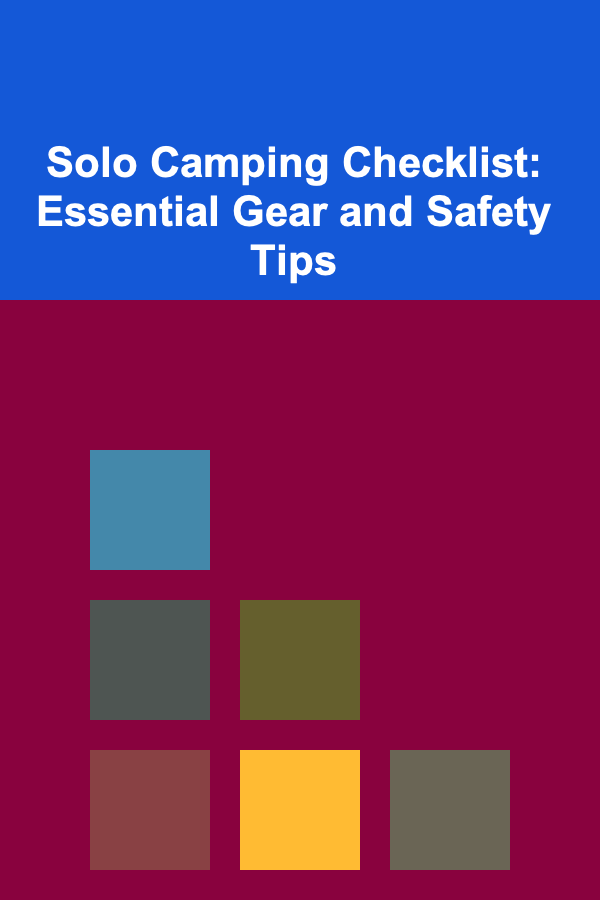
Solo Camping Checklist: Essential Gear and Safety Tips
ebook include PDF & Audio bundle (Micro Guide)
$12.99$5.99
Limited Time Offer! Order within the next:

Solo camping offers an incredibly rewarding experience that allows you to connect deeply with nature, find personal peace, and build self-reliance. However, when camping alone, proper preparation is crucial for a safe and enjoyable experience. Whether you're a seasoned camper or new to solo adventures, having a comprehensive checklist will help ensure that you're well-equipped for the trip. In this article, we'll explore the essential gear you'll need for solo camping and share valuable safety tips to help you make the most of your outdoor adventure.
Tent and Shelter
When camping solo, your shelter is your most important piece of equipment. A tent provides protection from the elements, insects, and wildlife, ensuring a comfortable and secure rest.
What to Look for in a Tent:
- Lightweight and compact: Choose a tent that's easy to carry, as weight and size are especially important when you're going solo.
- Weather-resistant: Ensure the tent is capable of withstanding the conditions in your chosen location (e.g., rain, wind, or cold).
- Easy setup: Look for a tent that is straightforward to set up on your own.
- Adequate space: A tent with enough room for you and your gear, without being overly bulky.
Additional Shelter Gear:
- Footprint: A groundsheet or footprint to protect the bottom of your tent from rocks, roots, and water.
- Tarp: A tarp can be useful for additional protection or as a rain shelter outside of your tent.
Sleeping Bag and Pad
To ensure a comfortable and restful sleep while camping solo, a good sleeping bag and pad are essential.
Sleeping Bag:
- Temperature rating: Choose a sleeping bag that suits the climate conditions of your destination. Check the temperature rating to ensure you'll stay warm enough at night.
- Material: Down sleeping bags are lighter and more compressible, but synthetic bags perform better when wet and dry faster.
- Fit: A mummy-style sleeping bag is ideal for solo camping as it's more compact and warmer.
Sleeping Pad:
- Insulation: A sleeping pad will not only provide comfort but also insulate you from the cold ground.
- Inflatable or foam: Inflatable pads offer more comfort, while foam pads are more durable and simpler to use.
Backpack
A reliable and well-fitted backpack is vital for carrying all your gear efficiently.
What to Consider:
- Capacity: For solo camping, a 40-60L backpack is ideal for an overnight or weekend trip. For longer trips, consider a larger pack.
- Fit: Ensure the backpack fits your torso length and waist size. A comfortable fit will prevent unnecessary strain during your hike.
- Accessibility: Choose a pack with easy access to your essentials, such as water bottles, snacks, and a first aid kit.
Clothing
The right clothing will protect you from the elements, keep you comfortable, and ensure you stay dry and warm.
Essential Clothing Items:
- Base layers: Opt for moisture-wicking fabrics like merino wool or synthetic materials for your base layers to keep you dry and warm.
- Insulating layer: A fleece or down jacket provides warmth without adding too much weight.
- Outer layer: A waterproof jacket or shell will protect you from rain and wind.
- Extra socks and underwear: Always pack an extra set of socks and underwear to keep your feet dry and comfortable.
- Hat, gloves, and scarf: Even in warm climates, temperatures can drop at night, so pack a hat, gloves, and a scarf for warmth.
- Sturdy boots: Comfortable and durable hiking boots are necessary for solo hikes, as they'll protect your feet and provide support.
Cooking and Food Preparation
For solo camping, food preparation should be simple yet satisfying. It's crucial to pack lightweight cooking gear and non-perishable food.
Cooking Gear:
- Camp stove: A lightweight, compact stove is essential for cooking hot meals. Popular options include canister stoves or alcohol stoves.
- Fuel: Ensure you bring the correct fuel for your stove and pack extra just in case.
- Cookware: A small pot, pan, or kettle will suffice for most solo meals. Choose lightweight, compact, and durable cookware made from materials like titanium or aluminum.
- Utensils: A spork, knife, and multi-tool will help with meal preparation and eating.
- Food storage: Bring a food container to store any perishable items securely. Bear-proof containers may be necessary if you're camping in wildlife-heavy areas.
Food:
- Non-perishable foods: Dried meals, trail mix, energy bars, and dehydrated fruits are excellent choices for solo camping. They're lightweight, easy to prepare, and pack a lot of nutrients.
- Snacks: Pack enough high-energy snacks like nuts, jerky, and granola bars for the duration of your trip.
- Water: Make sure you bring enough water or a reliable water filtration system for purifying water from streams or lakes.
Water and Hydration
Staying hydrated is essential when camping, especially when hiking or engaging in physical activities. There are several options for ensuring you have access to clean water during your solo trip.
Hydration Gear:
- Water bottle or hydration reservoir: A durable water bottle or hydration reservoir will help you carry enough water for your trip.
- Water filter or purification tablets: In case you don't have enough water on hand, a water filter or purification tablets will allow you to safely drink from natural water sources.
Navigation Tools
When solo camping, especially in unfamiliar areas, navigation is key to ensuring you don't get lost or disoriented.
Essential Navigation Tools:
- Map and compass: A physical map and compass are reliable navigation tools, even in the age of GPS.
- GPS device: If you prefer electronic navigation, a GPS device or smartphone with offline maps can help you track your location.
- Whistle: A whistle can be heard from a distance and is a great emergency signaling tool.
Emergency and First Aid Kit
Accidents can happen, especially when you're alone in the wilderness. A first aid kit and emergency supplies are crucial for dealing with minor injuries or unforeseen situations.
First Aid Kit Essentials:
- Bandages and gauze pads: For cuts, blisters, or minor injuries.
- Antiseptic wipes and ointment: To clean and disinfect wounds.
- Pain relievers: Ibuprofen or acetaminophen for pain relief.
- Tweezers: For removing splinters or ticks.
- Band-aids and blister pads: For protecting your feet and hands from blisters.
- Elastic bandage: For sprains or strains.
- Personal medications: Ensure you bring any required prescription medications.
Emergency Items:
- Headlamp or flashlight: A headlamp allows you to keep your hands free, making it easier to cook, set up camp, or hike in the dark.
- Extra batteries: Always pack extra batteries for your headlamp or flashlight.
- Fire starter: Waterproof matches, a lighter, or a firestarter kit are essential for building a fire for warmth or cooking.
- Survival whistle: A loud whistle can help you signal for help in an emergency.
Personal Care and Hygiene
Maintaining good hygiene is important for both comfort and health during your solo camping trip.
Hygiene Gear:
- Toothbrush and toothpaste: Travel-sized toothbrush and toothpaste to keep your mouth fresh.
- Biodegradable soap: Eco-friendly soap that won't harm the environment when used in outdoor settings.
- Hand sanitizer: To clean your hands when water isn't readily available.
- Towel: A lightweight, quick-drying towel for personal care.
- Toilet paper and trowel: If there are no restroom facilities, bring biodegradable toilet paper and a small shovel or trowel to bury waste.
Safety Tips for Solo Camping
When camping alone, safety should always be a priority. Here are some essential safety tips to keep in mind:
Pre-Trip Safety:
- Tell someone your plans: Always share your itinerary and expected return time with a friend or family member.
- Check the weather: Be prepared for changing conditions by checking the weather forecast before heading out.
- Know the area: Research your camping location, including potential hazards like wildlife, terrain, and trail conditions.
On the Trail:
- Stay on marked trails: Stick to established trails to avoid getting lost.
- Trust your instincts: If something doesn't feel right, don't hesitate to change your plans.
- Know emergency procedures: Familiarize yourself with the area's emergency protocols, including how to contact rescue services if necessary.
Conclusion
Solo camping is a transformative experience that allows you to reconnect with nature and push your limits. With the right gear and preparation, you can enjoy a safe and fulfilling adventure. Remember to pack the essentials, stay mindful of safety, and be self-reliant. Above all, enjoy the solitude and beauty that solo camping provides. Whether you're a beginner or an experienced camper, following this checklist will ensure that your solo camping trip is as enjoyable and rewarding as possible.
Reading More From Our Other Websites
- [Home Budget 101] How to Plan for a Home Renovation Without Exceeding Your Budget
- [Organization Tip 101] How to Incorporate Personal Touches into Your Supply Organization
- [Home Budget 101] How to Budget for Home Insurance and Find the Best Rates
- [Personal Care Tips 101] How to Choose a Non-Comedogenic Face Oil for Clear Skin
- [Personal Care Tips 101] How to Make a Facial Scrub with Natural Ingredients from Your Kitchen
- [Organization Tip 101] How to Use Categories for Easier Meal Prep
- [Personal Finance Management 101] How to Save Money on Groceries Without Extreme Coupons or Cutting Coupons at All
- [Home Cleaning 101] How to Organize Your Home for a Stress-Free Clean
- [Organization Tip 101] How to Use Video Doorbells for Added Security
- [Personal Care Tips 101] How to Find the Best Eye Cream for Anti-Aging

CRM Specialist's Handbook: Best Practices for Driving Customer Loyalty and Growth
Read More
How to Build a Membership Recruitment Checklist for Your Environmental Organization: A Detailed Actionable Guide
Read More
How to Save Money on Utilities with Smart Organization
Read More
How to Store Books in Small Spaces
Read More
How to Use Feedback from Volunteers to Improve Space
Read More
Top Budgeting Tips for Managing Your Money and Avoiding Debt
Read MoreOther Products

CRM Specialist's Handbook: Best Practices for Driving Customer Loyalty and Growth
Read More
How to Build a Membership Recruitment Checklist for Your Environmental Organization: A Detailed Actionable Guide
Read More
How to Save Money on Utilities with Smart Organization
Read More
How to Store Books in Small Spaces
Read More
How to Use Feedback from Volunteers to Improve Space
Read More